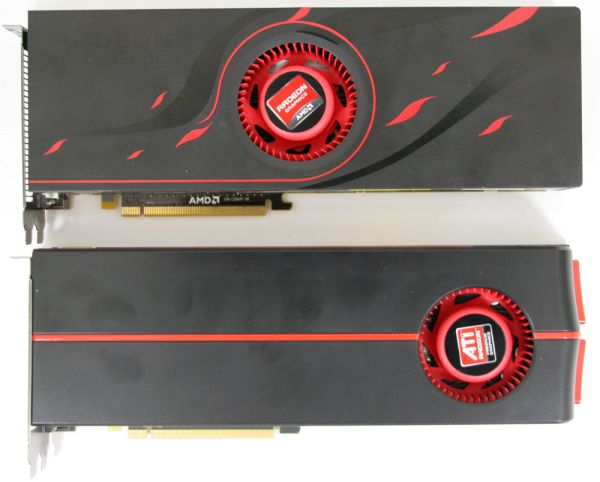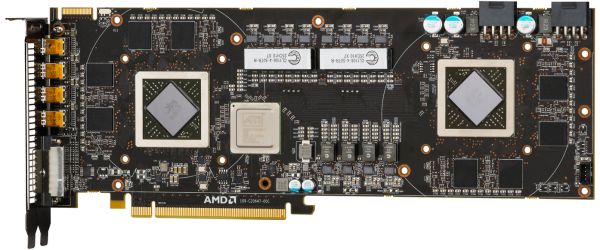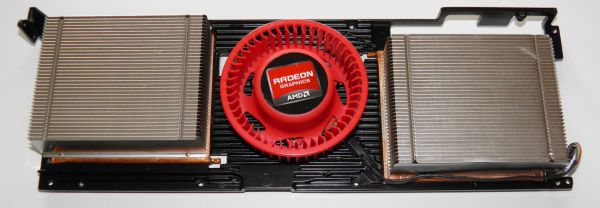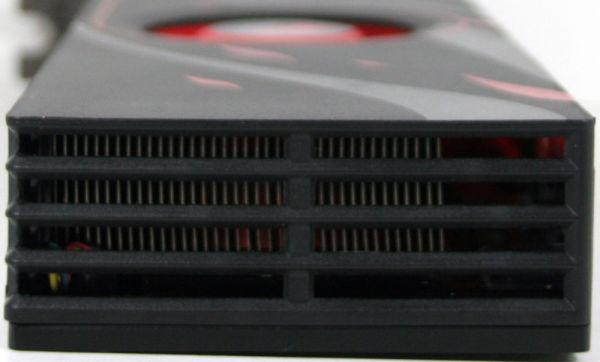AMD's Radeon HD 6990: The New Single Card King
by Ryan Smith on March 8, 2011 12:01 AM EST- Posted in
- AMD
- Radeon HD 6990
- GPUs
Meet The 6990
If you recall our coverage on the 5970, we found a few areas where AMD was lacking. The cooling on the 5970 was sufficient to run the GPUs even at 5870 clocks and voltages, however the cooling on the VRMs was lacking, leading to real world programs trigging the VRM thermal protection mechanism; and while this was within safety guidelines, it’s not a comfortable place to be for long term operation. This ultimately led to us writing off the 5970OC as a 100% reliable product, sticking to recommending the 5970 solely at stock speeds.
The design of the 6990 in turn reads very much like a response to our findings in true engineering fashion. Furthermore for the 6990 AMD not only had to take a look at the 5970’s weaknesses, but also how to handle an even greater power load. The result is that the 6990 is distinctly different from the 5970 before it.
Compared to the 5970, the 6990 is ever so slightly shorter, thanks in large part to the fact than the 6000 series casing is more squared off compared to the 5000 series’ tapered design. As a result it comes in at 11.5” for the PCB (the same as the 5970), and with casing a full 12” long compared to the 5970’s 12.16”. This means that the 6990 has effectively the same space requirements as the 5970, cooling notwithstanding.
Meanwhile it’s the fan however that is going to catch the most attention and this is where we’re going to dovetail in to cooling. The 5970’s traditional blower had its strengths and weaknesses, the strengths being that blowers are relatively forgiving about a case’s ability to exhaust hot air, and the weaknesses being that the GPU (and VRMs) closest to the fan received better cooling than the farther GPU. The VRMs proved to be particularly problematic, as they could overheat well before the GPUs did and AMD does not spin up their fans based on VRM temperatures.
Correcting for this and at the same time allowing for even greater heat dissipation, the rear blower design is out. Its replacement is a design that we’ve seen in 3rd party cards before such as the Asus ARES 5870X2, but not in a reference design: a center-mounted fan/blower with a GPU to each side. The difference is critical and indeed cannot be understated: a rear blower channels most hot air outside of the case, while a center-mounted blower effectively splits the card in two, with one GPU + supporting chips being exhausted outside of the case, and the 2nd GPU + supporting chips being exhausted inside the case. The design is still enclosed, so everything goes out either the front or back of the card while fresh air is pulled in the center.
With the replacement of the blower, so has gone the heatsink. The 5970’s single large vapor chamber + heatsink design has been replaced in favor of a segmented heatsink, further driving home the concept that the 6990 is closer to 2 video cards sharing 1PCB than it is 2 GPUs on one card. Each heatsink in turn is connected to the GPU via its own vapor chamber, resulting in the GPUs being fully isolated from each other as far as cooling is concerned.
Even the thermal paste connecting the GPUs to the vapor chambers has been changed for the 6990 – AMD has replaced traditional paste with a phase change material. Phase change materials – pastes/pads of material that melt and solidify based on temperature are nothing new, however they’re still exotic; material similar to what AMD is using is not readily available as paste is. AMD even went so far as to suggest that reviewers not directly disassemble their 6990s as it would require a new application of phase change paste in order to achieve the same efficiency as the original material. The net result of all of this by AMD’s numbers is that the phase change material is 8% better than the regular paste they’ve been using.
Rounding out our focus on cooling is the VRMs, which have been relocated in order to correct for the 5970’s limited VRM cooling capabilities. The VRMs and controllers are now at the center of the board – now they’re cooled before the GPUs or RAM modules are. The profoundness of this is twofold: not only is it an improvement on the 5970, but with the 6990’s higher power consumption VRM cooling is even more important. As with the 6970, voltage regulation is supplied by Volterra MOSFETs and controllers.
All told, while the 5970 was designed to handle and dissipate 400W of heat, the 6990 is officially designed for 450W. In practice, at its limits in our test rig this is closer to 500W. To handle and dissipate that much heat in roughly 72in3 of space is nothing short of amazing.


















130 Comments
View All Comments
iamezza - Tuesday, March 8, 2011 - link
This could make for an extremely valuable article for gamers on a budget. When does lack of PCIe bandwidth become an issue for running SLI/crossfire?Testing 580SLI at 2 x 8 and 2 x 16 modes would be a good place to start....
therealnickdanger - Tuesday, March 8, 2011 - link
It will be curious to see what impact the bandwidth will have... then again, even with the restriction, the current Sandy Bridge systems still dominate the previous chips.In reality, 16/16 or 8/8 really doesn't have much impact. The difference even at 2560x1600 with all the fixins in even the most demanding games is <1%. Unless AT's new test system will feature six displays and 4K+ resolutions, I'm not sure SNB-E is worth waiting so long for (yes, that could be perceived as a challenge!)
In any case, I'm looking forward to it! Thanks for the article!
shaggart5446 - Tuesday, March 8, 2011 - link
i hope u said the same thing when ur friend nvidia release their 590 card i also do hope u say the exact words that the 590 dont make any sence since a pair of 560 or 570 can give u the same performance as the 590 i cant wait to see ur article on the 590 ill be waiting for anand tfor this because we all know that the 590 are going to be down clockClownPuncher - Tuesday, March 8, 2011 - link
With cards designed specifically with multi monitor gaming in mind, you may want to include those resolutions. Buying this card for 1920x1200 would make zero sense.7Enigma - Wednesday, March 9, 2011 - link
I think it was good to have both. The number of people buying this card will likely have 30" displays, but I'm sure some (competetive FPS for example) will want extremely fluid display even in busy scenes, as well as the person that doesn't yet have the cash to upgrade to a big screen but plans to in the near future.I would also argue that there are likely vastly more people playing on large single-screen displays than eyefinity folks so this does make more sense. And honestly when some of the games are averaging in the sub 80-100 fps range, those minimum framerates approach questionable playability depending on type of game.
So basically as crazy as it is to say this, the graphical power isn't quite there yet to use Eyefinity at high detail settings in more recent and demanding games.
Nentor - Tuesday, March 8, 2011 - link
"With but a trio of exceptions, the 6990 doesn’t make sense compared to a pair of cards in Crossfire."This product is not meant to make any sense from a financial, performance or even practical standpoint.
It IS the fastest videocard and that is that.
I was watching a video last night on youtube of a chainsaw powered by a Buick's V8 engine (hG5sTLY0-V8). It goes through a tree trunk in a blink of an eye, but it had to be lifted by TWO men.
Sure is cool though.
Squuiid - Sunday, March 13, 2011 - link
It makes complete sense if you want SLI in a small form factor, mATX and such. (as do I).PCIe slots are at a premium, and so is space on a mATX board/case.
However, I think I'm going to wait and see what the 590 looks like...
Fhistleb - Tuesday, March 8, 2011 - link
I didn't even think that was possible. Though with what this is pushing out its a little expected I suppose.stangflyer - Tuesday, March 8, 2011 - link
I would like to see the 6990 and 5970 comparison in crysis and metro at eyefinity and single monitor res but with the 5970 at default clocks and close to 5870 clocks. When I am playing these games I have my 5970 at 850 core and 1150 memory and it runs all day without any throttling.The 5970 is handicapped at the default speeds as everyone can run at or real close to 5870 speeds. The core is easy at 850 but you may need to back down memory to 1150 or 1175.
Would love to see the true difference in the 5970 and 6990 this way.
The framebuffer will be the big difference at eyefinity res. with any aa applied.
stangflyer - Tuesday, March 8, 2011 - link
One thing I do like about the dual gpu amd cards is that I play a few games that use physx.. (I have a 5970) I have a 250gts in the second pcie slot. both my slots are 2x16. This way I have a powerfull gpu and physx! I play my games at 5040x1050 and a single card just don't cut it. I did use nvidia surround for 2 months but like my eyefinity setup better. To go crossfire and then have physx you need a motherboard that doesn't knock your pcie slot down to 8x with 3 cards which are few and expensive and also a case that has space for that 3rd card like a coolermaster haf 932X. I have a haf 932 (not X) and I could not go 3 cards unless the 3rd card is single slot.On a side note as to why I am sticking with my 5970 till the 28nm show up is that I like the way the cooler is set up. With the fan on the end I have my 250gts below it with about a 3/8 inch below it. BUT the 250gts is only about 7.5-8 inches long and does not cover the fan at all because the fan is at the end. I have a 120mm fan at the bottom of my haf 932 case that blows straight up into the 5970 fan.
If I used a 6990 the 250gts would cover the 6990 fan.
My choices would be then to sell the 250gts and get a single slot card. (450gts probably)
I think I am just going to stay with what I have for now.
Maybe! LOL!